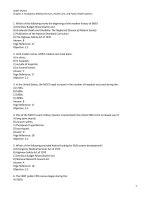Business statistics a decision making approach 6th edition ch04ppln
Bạn đang xem bản rút gọn của tài liệu. Xem và tải ngay bản đầy đủ của tài liệu tại đây (235.8 KB, 41 trang )
Business Statistics:
A Decision-Making Approach
6th Edition
Chapter 4
Using Probability and
Probability Distributions
Business Statistics: A Decision-Making Approach, 6e © 2010 PrenticeHall, Inc.
Chap 4-1
Chapter Goals
After completing this chapter, you should be able to:
Explain three approaches to assessing probabilities
Apply common rules of probability
Use Bayes’ Theorem for conditional probabilities
Distinguish between discrete and continuous
probability distributions
Compute the expected value and standard deviation
for a discrete probability distribution
Business Statistics: A Decision-Making Approach, 6e © 2010 PrenticeHall, Inc.
Chap 4-2
Important Terms
Probability – the chance that an uncertain event will
occur (always between 0 and 1)
Experiment – a process of obtaining outcomes for
uncertain events
Elementary Event – the most basic outcome
possible from a simple experiment
Sample Space – the collection of all possible
elementary outcomes
Business Statistics: A Decision-Making Approach, 6e © 2010 PrenticeHall, Inc.
Chap 4-3
Sample Space
The Sample Space is the collection of all
possible outcomes
e.g. All 6 faces of a die:
e.g. All 52 cards of a bridge deck:
Business Statistics: A Decision-Making Approach, 6e © 2010 PrenticeHall, Inc.
Chap 4-4
Events
Elementary event – An outcome from a sample
space with one characteristic
Example: A red card from a deck of cards
Event – May involve two or more outcomes
simultaneously
Example: An ace that is also red from a deck of
cards
Business Statistics: A Decision-Making Approach, 6e © 2010 PrenticeHall, Inc.
Chap 4-5
Visualizing Events
Contingency Tables
Ace
Sample
Space
Tree Diagrams
Full Deck
of 52 Cards
Not Ace
Total
Black
2
24
26
Red
2
24
26
Total
4
48
52
Car
k
c
a
Bl
Red C
a
d
Ac e
2
Not an Ace
Ace
rd
Business Statistics: A Decision-Making Approach, 6e © 2010 PrenticeHall, Inc.
Not an
A
Sample
Space
24
2
ce
24
Chap 4-6
Elementary Events
A automobile consultant records fuel type and
vehicle type for a sample of vehicles
2 Fuel types: Gasoline, Diesel
3 Vehicle types: Truck, Car, SUV
6 possible elementary events:
e1
Gasoline, Truck
e2
Gasoline, Car
e3
Gasoline, SUV
e4
Diesel, Truck
e5
Diesel, Car
e6
Diesel, SUV
Business Statistics: A Decision-Making Approach, 6e © 2010 PrenticeHall, Inc.
Ga
ine
l
o
s
Die
sel
k
Truc
Car
e1
SUV
e3
k
Truc
Car
SUV
e2
e4
e5
e6
Chap 4-7
Probability Concepts
Mutually Exclusive Events
If E1 occurs, then E2 cannot occur
E1 and E2 have no common elements
E1
Black
Cards
E2
Red
Cards
Business Statistics: A Decision-Making Approach, 6e © 2010 PrenticeHall, Inc.
A card cannot be
Black and Red at
the same time.
Chap 4-8
Probability Concepts
Independent and Dependent Events
Independent: Occurrence of one does not
influence the probability of
occurrence of the other
Dependent: Occurrence of one affects the
probability of the other
Business Statistics: A Decision-Making Approach, 6e © 2010 PrenticeHall, Inc.
Chap 4-9
Independent vs. Dependent
Events
Independent Events
E1 = heads on one flip of fair coin
E2 = heads on second flip of same coin
Result of second flip does not depend on the result of
the first flip.
Dependent Events
E1 = rain forecasted on the news
E2 = take umbrella to work
Probability of the second event is affected by the
occurrence of the first event
Business Statistics: A Decision-Making Approach, 6e © 2010 PrenticeHall, Inc.
Chap 4-10
Assigning Probability
Classical Probability Assessment
P(Ei) =
Number of ways Ei can occur
Total number of elementary events
Relative Frequency of Occurrence
Relative Freq. of Ei =
Number of times Ei occurs
N
Subjective Probability Assessment
An opinion or judgment by a decision maker about
the likelihood of an event
Business Statistics: A Decision-Making Approach, 6e © 2010 PrenticeHall, Inc.
Chap 4-11
Rules of Probability
Rules for
Possible Values
and Sum
Individual Values
Sum of All Values
k
0 ≤ P(ei) ≤ 1
For any event ei
∑ P(e ) = 1
i=1
i
where:
k = Number of elementary events
in the sample space
ei = ith elementary event
Business Statistics: A Decision-Making Approach, 6e © 2010 PrenticeHall, Inc.
Chap 4-12
Addition Rule for Elementary
Events
The probability of an event Ei is equal to
the sum of the probabilities of the
elementary events forming Ei.
Ei = {e1, e2, e3}
then:
P(Ei) = P(e1) + P(e2) + P(e3)
Business Statistics: A Decision-Making Approach, 6e © 2010 PrenticeHall, Inc.
Chap 4-13
Complement Rule
The complement of an event E is the
collection of all possible elementary events
not contained in event E. The complement of
event E is represented by E.
E
Complement Rule:
P( E ) = 1 − P(E)
E
Or,
Business Statistics: A Decision-Making Approach, 6e © 2010 PrenticeHall, Inc.
P(E) + P( E ) = 1
Chap 4-14
Addition Rule for Two Events
■
Addition Rule:
P(E1 or E2) = P(E1) + P(E2) - P(E1 and E2)
E1
+
E2
=
E1
E2
P(E1 or E2) = P(E1) + P(E2) - P(E1 and E2)
Don’t count common
elements twice!
Business Statistics: A Decision-Making Approach, 6e © 2010 PrenticeHall, Inc.
Chap 4-15
Addition Rule Example
P(Red or Ace) = P(Red) +P(Ace) - P(Red and Ace)
= 26/52 + 4/52 - 2/52 = 28/52
Type
Color
Red
Black
Total
Ace
2
2
4
Non-Ace
24
24
48
Total
26
26
52
Business Statistics: A Decision-Making Approach, 6e © 2010 PrenticeHall, Inc.
Don’t count
the two red
aces twice!
Chap 4-16
Addition Rule for
Mutually Exclusive Events
If E1 and E2 are mutually exclusive, then
P(E1 and E2) = 0
E1
E2
So
0 utualvlye
P(E1 or E2) = P(E1) + P(E2) - P(E1 and E2)
= if m lusi
c
ex
= P(E1) + P(E2)
Business Statistics: A Decision-Making Approach, 6e © 2010 PrenticeHall, Inc.
Chap 4-17
Conditional Probability
Conditional probability for any
two events E1 , E2:
P(E1 and E 2 )
P(E1 | E 2 ) =
P(E 2 )
where
P(E 2 ) > 0
Business Statistics: A Decision-Making Approach, 6e © 2010 PrenticeHall, Inc.
Chap 4-18
Conditional Probability
Example
Of the cars on a used car lot, 70% have air
conditioning (AC) and 40% have a CD player
(CD). 20% of the cars have both.
What is the probability that a car has a CD player,
given that it has AC ?
i.e., we want to find P(CD | AC)
Business Statistics: A Decision-Making Approach, 6e © 2010 PrenticeHall, Inc.
Chap 4-19
Conditional Probability
Example
Of the cars on a used car lot, 70% have air
(AC) and 40% have a CD player (CD).
20% of the cars have both.
CD
No CD
Total
AC
.2
.5
.7
No AC
.2
.1
.3
Total
.4
.6
1.0
(continued
)
conditioning
P(CD and AC) .2
P(CD | AC) =
= = .2857
P(AC)
.7
Business Statistics: A Decision-Making Approach, 6e © 2010 PrenticeHall, Inc.
Chap 4-20
Conditional Probability
Example
(continued
)
Given AC, we only consider the top row (70% of the cars). Of these,
20% have a CD player. 20% of 70% is about 28.57%.
CD
No CD
Total
AC
.2
.5
.7
No AC
.2
.1
.3
Total
.4
.6
1.0
P(CD and AC) .2
P(CD | AC) =
= = .2857
P(AC)
.7
Business Statistics: A Decision-Making Approach, 6e © 2010 PrenticeHall, Inc.
Chap 4-21
For Independent Events:
Conditional probability for
independent events E1 , E2:
P(E1 | E 2 ) = P(E1 )
where
P(E 2 ) > 0
P(E 2 | E1 ) = P(E 2 )
where
P(E1 ) > 0
Business Statistics: A Decision-Making Approach, 6e © 2010 PrenticeHall, Inc.
Chap 4-22
Multiplication Rules
Multiplication rule for two events E1 and E2:
P(E1 and E 2 ) = P(E1 ) P(E 2 | E1 )
Note: If E1 and E2 are independent, then P(E 2 | E1 ) = P(E 2 )
and the multiplication rule simplifies to
P(E1 and E 2 ) = P(E1 ) P(E 2 )
Business Statistics: A Decision-Making Approach, 6e © 2010 PrenticeHall, Inc.
Chap 4-23
Tree Diagram Example
0.2
=
)
E
(E 3| 1
k: P
Truc
Car: P(E4|E1) = 0.5
Gasoline
P(E1) = 0.8
Diesel
P(E2) = 0.2
SUV:
P(E
5
|E1 ) =
6
Truc
Car: P(E4|E2) = 0.1
SUV:
P(E
5
|E2 ) =
0.3
Business Statistics: A Decision-Making Approach, 6e © 2010 PrenticeHall, Inc.
P(E1 and E4) = 0.8 x 0.5 = 0.40
P(E1 and E5) = 0.8 x 0.3 = 0.24
0.3
= 0.
)
E
|
2
k: P(E 3
P(E1 and E3) = 0.8 x 0.2 = 0.16
P(E2 and E3) = 0.2 x 0.6 = 0.12
P(E2 and E4) = 0.2 x 0.1 = 0.02
P(E3 and E4) = 0.2 x 0.3 = 0.06
Chap 4-24
Bayes’ Theorem
P(Ei )P(B | Ei )
P(Ei | B) =
P(E1 )P(B | E1 ) + P(E 2 )P(B | E 2 ) + + P(Ek )P(B | Ek )
where:
Ei = ith event of interest of the k possible events
B = new event that might impact P(Ei)
Events E1 to Ek are mutually exclusive and collectively
exhaustive
Business Statistics: A Decision-Making Approach, 6e © 2010 PrenticeHall, Inc.
Chap 4-25









